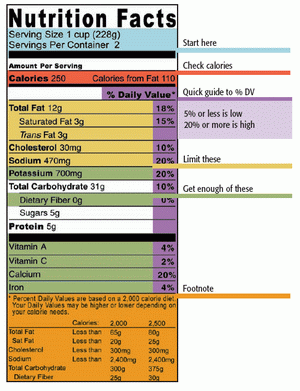Nutrition Facts Panel – Understanding Food Product Labels
The nutrition facts panel is the familiar label on packages of food items that provides nutrition information that can help the health conscious consumer to determine if the food product that they are purchasing when they go shopping for groceries is low calorie, contains low salt/sodium, contains whole grains, how much fat is present and what the overall nutritional value of the food product is.
Statistics have shown that 91% of shoppers purchasing a product for the first time will read the nutrition label and that 83% read the label on a regular basis when grocery shopping, so the information is considered important by quite a few people.

The nutrition facts panel contains:
1. Title – Nutrition Facts
2. Serving Size – this is a standardized reference amount that should be double checked since this may not be the amount that you normally eat.
3. Calories Per Serving – this shows the number of calories per serving and the amount of calories from total fat and the breakdown of saturated fats and trans fats.
4. List of Nutrients - The information contains the amount of cholesterol, sodium, and carbohydrates broken down into dietary fibers and sugars; as well as protein, in addition to total fats and its breakdown into saturated and trans fat.
5. % Daily Values of the list of nutrients are given in grams or milligrams per serving and are based on the values given lower down on the label in the footnote.
6. Daily Value Footnote – The % daily values are shown for two caloric intake levels, so it is important for each individual to evaluate what their own diet is. The footnote also contains information about the amount of Vitamin A, Vitamin C, and the minerals iron and calcium.
7. Caloric Conversion Information – Reference values so that you can double check your own conversions to make sure that they are accurate.
For a close up of the nutrition facts panel in an enlarged view with an explanation of the nutrition information that is provided on the panel go to www.fda.gov.
How can the average grocery shopper use food labels to make wise and healthy choices in food products?
Perhaps by considering some of the reasons that certain information is placed on food labels, as a result of claims regarding the benefits of certain nutrients, information such as:
• The role that getting enough calcium and Vitamin D plays in reducing the risk of osteoporosis.
• The role that low fat diets may play in reducing the risk for certain types of cancers.
• The role that certain types of dietary fiber may play in lowering the risk of heart disease.
• That role that diets rich in fruits and vegetables may play in reducing the risk of certain types of cancers.
• The role that diets containing a good source and amount of potassium may play in reducing the risk of high blood pressure and stroke.
• The role that soy proteins may play in the diets of menopausal and post menopausal women of reducing the risk of heart disease.
• The role that certain types of whole grains may play in reducing the risk of heart disease and certain types of cancers. These are only a few of the many health claims that have been allowed to be associated with adding information about certain dietary components to food labels, based on scientific research, since these claims cannot be added without some level of supporting proof.
The use of the nutrition facts panel food labels is an opportunity to implement the dietary guidelines for Americans and the choosemyplate diet plan to make healthier food choices and reduce the risk of certain chronic diseases. For other information on nutrition including information about using the nutrition facts panel some great references are:
• Nutrition – Fourth Edition by Paul Insel, Don Ross, Kimberley McMahon, and Melissa Bernstein
Cooking Basics
Food Safety
Herbs and Spices
Cooking and Nutrition
Nutrients In Food
Energy From Food
Nutrition Planning
Dietary Guidelines
Nutritious Food Choices
Cooking Easy Recipes Home
Nutrition Label

Get great cooking tips and download your free ecookbook when you sign up for the Cooking Partner newsletter





